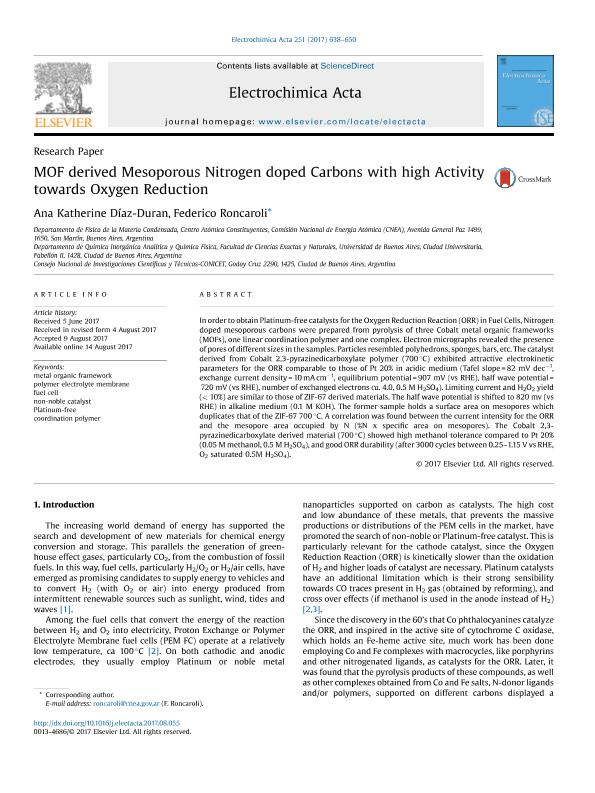Artículo
MOF derived Mesoporous Nitrogen doped Carbons with high Activity towards Oxygen Reduction
Fecha de publicación:
10/2017
Editorial:
Pergamon-Elsevier Science Ltd
Revista:
Electrochimica Acta
ISSN:
0013-4686
Idioma:
Inglés
Tipo de recurso:
Artículo publicado
Clasificación temática:
Resumen
In order to obtain Platinum-free catalysts for the Oxygen Reduction Reaction (ORR) in Fuel Cells, Nitrogen doped mesoporous carbons were prepared from pyrolysis of three Cobalt metal organic frameworks (MOFs), one linear coordination polymer and one complex. Electron micrographs revealed the presence of pores of different sizes in the samples. Particles resembled polyhedrons, sponges, bars, etc. The catalyst derived from Cobalt 2,3-pyrazinedicarboxylate polymer (700 °C) exhibited attractive electrokinetic parameters for the ORR comparable to those of Pt 20% in acidic medium (Tafel slope = 82 mV dec−1, exchange current density = 10 mA cm−1, equilibrium potential = 907 mV (vs RHE), half wave potential = 720 mV (vs RHE), number of exchanged electrons ca. 4.0, 0.5 M H2SO4). Limiting current and H2O2 yield (< 10%) are similar to those of ZIF-67 derived materials. The half wave potential is shifted to 820 mv (vs RHE) in alkaline medium (0.1 M KOH). The former sample holds a surface area on mesopores which duplicates that of the ZIF-67 700 °C. A correlation was found between the current intensity for the ORR and the mesopore area occupied by N (%N x specific area on mesopores). The Cobalt 2,3-pyrazinedicarboxylate derived material (700 °C) showed high methanol tolerance compared to Pt 20% (0.05 M methanol, 0.5 M H2SO4), and good ORR durability (after 3000 cycles between 0.25–1.15 V vs RHE, O2 saturated 0.5M H2SO4).
Archivos asociados
Licencia
Identificadores
Colecciones
Articulos(SEDE CENTRAL)
Articulos de SEDE CENTRAL
Articulos de SEDE CENTRAL
Citación
Diaz Duran, Ana Katherine; Roncaroli, Federico; MOF derived Mesoporous Nitrogen doped Carbons with high Activity towards Oxygen Reduction; Pergamon-Elsevier Science Ltd; Electrochimica Acta; 251; 10-2017; 638-650
Compartir
Altmétricas




